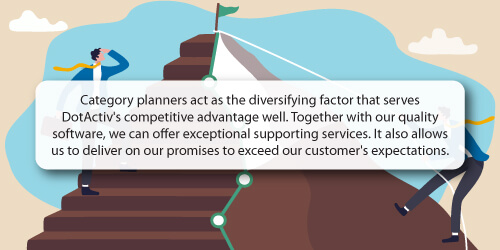In the competitive world of retail, our clients need a trusted advisor that can help them make decisions that lead to a positive impact. What better advisor than a category planner? Why? Because they plan and coordinate future inventory and sales volume in one or more product categories, drive sales and profit and transform the in-store experience.

But what does the average day look like if you're working as a category planner at DotActiv? What are your responsibilities? And how do we deliver value to our clients? We unpack all of these questions below and more.

What is a category planner?
Before we unpack the role and responsibilities of a category planner, it's worth explaining what a category planner is to set the scene.
From the title, it sounds straightforward. You plan categories. Dig a little deeper, however, and you'll soon find it's far more complex.
As a category planner, you plan category clusters, create product ranges, build planograms by analysing data and execute retail strategies.
You're thus a master of category management and all that it entails. You're the expert a retailer calls on when they need to restructure their product groupings. You're the trusted advisor who can offer recommendations to improve a retail business.

What to expect as a DotActiv category planner
It is also worth pointing out that the expert knowledge of implementing DotActiv's end-to-end integration systems is the golden thread to optimising a retail business. As a category planner, your role is critical to the success of any of DotActiv's clients.
As written above, you'll know how to optimise category clusters, product assortments and placements and oversee effective category and in-store changes. That means the responsibilities are broad.
So what are your responsibilities as a category planner at DotActiv? We labelled them according to each function within the DotActiv software.
Clustering
- Fine-tuning store clusters per category;
- Developing optimised cluster plans per product category using the Cluster Optimiser and maintenance tools in the DotActiv software; and
- Analysing the cluster plan and profiling each cluster to deliver strategic insights to clients.
Assortment Planning
- Creating strategic assortment plans;
- Optimising product assortments based on consumer behaviour;
- Recommending product assortments that fit within the category space;
- Allocating and reviewing product space allocations;
- Understanding and ensuring transferable demand.
Space Planning/Floor Planning
- Designing and planning data-driven floor space plans, shelf plans and planograms; and
- Conducting floor and space plan analytical reviews.
Advising/Analysing
- Maximising customer and category performance by considering category strategies and plans, product financial performance, shopper psychology and aesthetic appeal; and
- Supporting, advising and guiding retail customers where required.
It is worth noting that the above is not the be-all and end of your responsibilities as a DotActiv category planner. However, it should give you a good idea of what to expect.

Unpacking the average day of a category planner at DotActiv
Any DotActiv category planner, if you ask them, will tell you that the above are only a few of their responsibilities. Similar to the day of a DotActiv space planner, you could argue the majority of your time consists of cluster, range and planogram production. You could allocate the remaining time - 40% for argument's sake - to communication, reporting and data analysis.
Nonetheless, your day can differ based on the product or category you work on and the season or promotional period. That aside, let’s take a closer look at the average day in the life of a DotActiv category planner.
1. Analyse data
DotActiv bases all of its recommendations on store or category data analysis. That's because, without retail data, any suggestions are guesswork.
By identifying trends and fluctuations in the data, a category planner can suggest changes to the product range or product placements on a planogram. In doing this, they can optimise a product assortment while improving the customer experience.
2. Product Research
Product knowledge of a category is crucial to understanding consumer buying behaviour and visible trends within the relevant data. As a category planner, we expect you to conduct product research and attend meetings with suppliers to understand how their customers purchase and consume their products.

The benefit is that you can provide credible insights and recommendations to retailers. It allows you to become a reliable partner and someone to be trusted.
3. Implement the end-to-end category management process
When working on a new category, you begin by developing store clusters. You complete this by grouping stores with similar consumer behaviours.
From there, you would work on creating a tailored product assortment. It's the type of assortment that would satisfy the needs of your target market within each cluster.
Lastly, you would create visually aesthetic planograms. These planograms would represent the category and product assortment for each cluster. Since they are also data-driven, they would consider the space available within each relevant store. That means providing enough products (and not too many) to satisfy consumer demand.
4. Attend buyer and supplier meetings
Throughout the entire category management process, and before it begins, we require you to meet with your category buyers. As mentioned above, there are good reasons for it.
Besides the already-mentioned reasons, another is that you need to gather input and accumulate expert advice. That allows you to be aware of and continually implement the retail buyer's vision for the category. After all, this isn't about receiving input at the start of the process and then executing it.
Instead, this is a collaborative process where continued input leads to success. It also means that you can become a trusted advisor. When discussing why it's worth including a product in the range or why an item needs more space, the category buyer will listen to what you have to say.

Unpacking the DotActiv category planner BPVC
Firstly, BPVC is an acronym for Business Process Value Chain. It's a business model that provides an in-depth explanation of each activity that has to take place to transform a product or service from an idea to reality. DotActiv’s Category Planner BPVC gives you the exact steps to follow when building a planogram from start to finish and everything in between.
So why is the BPVC critical for a category planner?
- We want to equip you to do your job to the best of your ability;
- We provide you with training and a document (the BPVC) that you can consult at any time to guide you when building a planogram; and
- The BPVC increases your efficiency and productivity.
Here are some high-level steps for the category planning process according to our BPVC:
- Review the account context;
- Determine the category performance objectives;
- Optimise the clusters;
- Optimise the assortment;
- Optimise the planogram;
- Conduct performance analysis
We use our category planner BPVC to conduct the various steps to create planograms for our clients. As part of the mentioned steps, we also hold four structured consultations to gather the necessary information to meet a client's objectives. We believe in working with our clients to ensure we help them meet their goals and objectives.
These consultations are as follows:
1. We confirm the performance objectives
The goal is to confirm the performance objectives and needs of the category.
2. We present the preliminary plan
The goal is to stress-test the suggested preliminary category plan before the final output. It is also to refine it where necessary.
3. We deliver the plan
The goal of this presentation-based consultation is not only to deliver the final output. It is also to explain the rationale behind our final outcome.
4. We unpack the results and make tweaks
The goal is to unpack the implementation results and talk through the learnings.

Conclusion
The category management process is one that is collaborative. As a DotActiv category planner, you’re in the best position to provide expert advice and recommendations on optimising store clusters, product assortments and product placements for an enhanced shopping experience and improved category performance.
Are you interested in starting your journey as a category planner at DotActiv? We’d love to hear from you. You can read up about DotActiv, what we stand for and how we operate here or apply for any open positions here.


